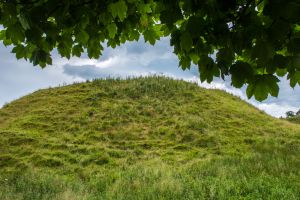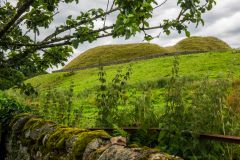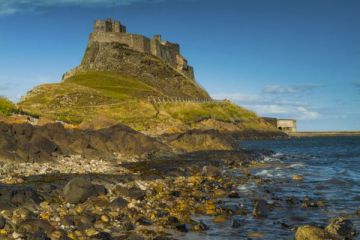
The castle was probably built by Robert de Umfraville, a relative of William the Conqueror. William wanted someone he could trust on the northern frontier of his new kingdom. He named Umfraville as the Lord of Redesdale and exempted him from military service on the condition that he guard his territory against robbers and wolves.
The Umfravilles were a law unto themselves in Redesdale. They appointed judges, exercised justice, were allowed to hold fairs, and were granted the right to hunt in royal forests. They essentially held the power of life and death over the inhabitants of Redesdale.
At Elsdon, the Umfravilles created a circular motte topped by a timber fortification. The bailey below the motte was protected by an earthen bank and ditch, with a timber palisade atop the bank. Little in the way of foundations can be seen, but a carved Roman stone was found on the site, believed to have come from the Roman camp at Rochester.
An old folk legend tells that a giant lived on the castle mound, and spread a reign of terror over the neighbourhood. Perhaps this was a folk memory expressing the reign of the Norman Umfravilles?
Elsdon Castle is accessible at any time.
Also in the village is Elsdon Tower, a 14th or 15th-century vicar's pele, or tower house, rebuilt in the 16th century. It may also have been built by the de Umfravilles.
Visiting
Elsdon Castle can be hard to find unless you know where to look. There were no signposts from the main roads through Elsdon the last time we visited, but a bit of exploration soon set us in the right direction. Take the lane leading to the village hall. Past the hall, the lane turns into a driveway so that it looks like a dead end.
If you walk up the drive you will see the castle motte on your left. Carry on up the drive and you will come to a wooden gate on the left leading into the field with the motte. There is an information panel set up by Northumberland National Park just inside the gate, with an artists illustration of how the castle would have looked at its height, plus a short history of the site.
There are no obvious trails around the site and it is a steep climb up to the top of the twin mottes. My only company atop the castle were a pair of sheep who scampered away when they saw me coming.





 We've 'tagged' this attraction information to help you find related historic attractions and learn more about major time periods mentioned.
We've 'tagged' this attraction information to help you find related historic attractions and learn more about major time periods mentioned.


